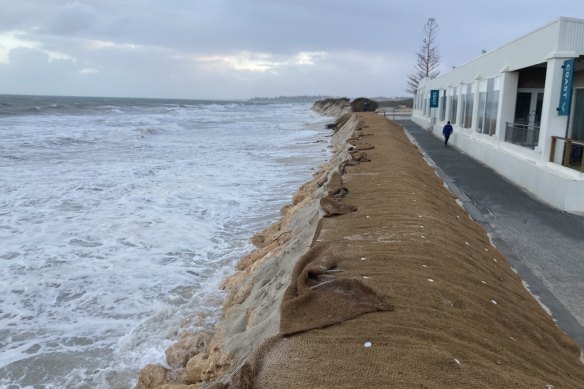This was published 4 months ago
WA coastal erosion and flooding now predictable seven days in advance
In a world first, a real-time forecasting map of Western Australia’s coastline is helping predict impending beach erosion and flooding a week ahead of time.
The national early warning system has been piloted in two geographically distinct regions – one stretching about 350 kilometres between Dunsborough in WA’s south and Two Rocks in the north; and the second, a 450-kilometre section north and south of Sydney.

UWA researchers say a new portal, released ahead of winter, will allow the public to see coastal erosion and flooding forecasts.Credit: University of Western Australia
The coastal hazard system predicts the severity of tidal and storm impacts every 100 metres alongshore and at vulnerable hotspots with at-risk housing and infrastructure.
The Framework for national-scale coastal storm hazards early warning was developed by University of NSW engineers in partnership with the Australian Bureau of Meteorology, the University of Western Australia, WA Department of Transport and the City of Mandurah.
A team led by the UWA’s Oceans Institute set up five coastal monitoring systems in Mandurah and has conducted monthly drone surveys at the hotspot since 2019.
Research fellow Michael Cuttler said the team, working with local governments and Transport, provided a valuable WA perspective to the project.
“The east coast has a lot of big headlands and embayed beaches, and we have a lot of near shore rocky and limestone reefs, which throws a bit of a curveball into the near shore physics,” he said.
“We’re still gathering a lot of knowledge on the background dynamics of how things operate on this coast but this forecasting system is a good step forward to get everybody’s heads tuned into being aware of cause and response.”
While data collection of this kind may influence perspectives on issues like climate change in the future, this study, says Cuttler, focuses much more on the short-term response.
“This is a seven-day forecast, if you were planning a trip, you might look at the weather forecast to see if you should pack a rain jacket – This is the equivalent of that but for coastal erosion,” he said.
“If there’s a really bad event forecast, it could trigger protective actions in those areas.”
The web portal is now accessible to the public and local agencies ahead of winter.
“It’s good timing for it to be released and published because we may see some [weather events] coming in the next couple of weeks, and we should get some good feedback as to how well it’s working,” Cuttler said.
UNSW’s Water Research Lab lead researcher Professor Ian Turner said rolling seven-day forecasts would help coastal managers and emergency response agencies better prepare for emergencies.
“We’re accustomed to checking weather apps for hazardous heat, rain, wind, even surf,” he said.
“But while we’ve seen some pretty dramatic impacts of storms on the coast, to our knowledge, national forecasting agencies around the world don’t have the capability to send out a coastal erosion warning when a storm is approaching.”
Start the day with a summary of the day’s most important and interesting stories, analysis and insights. Sign up for our Morning Edition newsletter.